制药工程专业英语 Unit 13 课文翻译
- 格式:doc
- 大小:49.50 KB
- 文档页数:5

Unit 1 Production of DrugsAbout 5000 antibiotics have already been isolated from microorganisms,but of these only somewhat fewer than 100 are in therapeutic use. It must be remembered,however,that many derivatives have been modified by partial synthesis for therapeutic use;some 50,000 agents have been semisynthetically obtained from户lactams alone in the last decade. Fermentations are carried out in stainless steel fermentors with volumes up to 400 m3. To avoid contamination of the microorganisms with phages etc. the whole process has to be performed under sterile conditions. Since the more important fermentations occur exclusively under aerobic conditions a good supply of oxygen or air(sterile)is needed. Carbon dioxide sources include carbohydrates,e. g. molasses,saccharides,and glucose. Additionally the microorganisms must be supplied in the growth medium with nitrogen-containing compounds such as ammonium sulfate,ammonia,or urea,as well as with inorganic phosphates. Furthermore,constant optimal pH and temperature are required. In the case of penicillin G,the fermentation is finished after 200 hours,and the cell mass is separated by filtration. The desired active agents are isolated from the filtrate by absorption or extraction processes. The cell mass,if not the desired product,can be further used as an animal feedstuff owing to its high protein content.关于5000抗生素已经分离出的微生物,但其中只有不到100有些治疗使用。

制药工程专业英语Unit 1production of drugs P1单词Compound 化合物intermediate 中间产物alkaloids 生物碱enzymes酶peptide 肽hormones 荷尔蒙modification 修饰chloramphenicol 氯霉素metabolites 代谢物substitute 替代品derivative衍生物active 活性absorption 吸收extraction 提取Recombinant 重组insulin 编码neuroactive 神经活性start materials 起始原料recrystallization 重结晶methanol 甲醇Ethanol 乙醇isopropanol 异丙醇butanol 丁醇benzene 苯翻译Known examples are the enzymatic cleavage of racemates of N-acetyl-D, L-amino acids to give L-amino acids, the production of 6-aminopenicillanic acid from benzylpenicillin by means of penicillinamidase and the aspartase-catalysed stereospecific addition of ammonia to fumaric acid in order to produce L-aspartic acid.著名的例子是对N -乙酰- D,L -氨基酸消旋给予L -氨基酸酶裂解,从青霉素生产8 -氨基青霉烷酸的青霉素酰胺酶手段和天冬氨酸酶,催化氨立体除了富马酸为了酸生产L -天门冬氨酸。
Reading material 1 p7Antagonist 抑制剂receptor 受体clinical investigation 临床研究antibacterial抗菌的inhibition 抑制mercurial 水银dominate 占主导Unit 3 chemotherapy: an introduction P29单词chemotherapy化学治疗superstition 迷信pathogenic 致病的翻译The activity of the arsenical drugs is explained as due to a blocking of essential thiol groups.For example, lipoic acid dehydrogenase contains two cysteine molecules, while are kept near each other by folding of the molecule. As a result, an arsenical can react with these thiol groups and inactivate the molecule, as show in equation.对含砷药物活性被解释为由于阻塞必不可少的巯基。

Unit 1 Production of DrugsDepending on their production or origin pharmaceutical agents can be split into three groups:I .Totally synthetic materials (synthetics),Ⅱ.Natural products,andⅢ.Products from partial syntheses (semi-synthetic products).The emphasis of the present book is on the most important compounds of groups I and Ⅲ一thus Drug synthesis. This does not mean,however,that natural products or other agents are less important. They can serve as valuable lead structures,and they are frequently needed as starting materials or as intermediates for important synthetic products.Table 1 gives an overview of the different methods for obtaining pharmaceutical agents.1单元生产的药品其生产或出身不同药剂可以分为三类:1。
完全(合成纤维)合成材料,Ⅱ。
天然产物,和Ⅲ。
产品从(半合成产品)的部分合成。
本书的重点是团体的最重要的化合物Ⅰ和Ⅲ一所以药物合成。
这并不意味着,但是,天然产品或其他代理人并不太重要。
它们可以作为有价值的领导结构,他们常常为原料,或作为重要的合成中间体产品的需要。

1、Digitalis is one of the most frequently used medications in the treatment of heart failure and arrhythmia. It increases the contractility of the heart muscle and modifies vascular resistance. It also slows conduction through the atrioventricular node in the heart, making it useful in the treatment of atrial fibrillation and other rapid heart rhythms洋地黄是其中一个最常用的药物治疗心力衰竭和心律失常。
它增加了的心肌收缩血管阻力和修改。
它也减慢传导通过传导节点的心使它有用的治疗房颤和其他快速心律2、The formulation of a parenteral product involves the combination of one or more ingredientswith a medicinal agent to enhance the convenience,acceptability,or effectiveness of the product. Rarely is it preferable to dispense a drug singly as a sterile dry powder unless the formulation of a stable liquid preparation is not possible非肠道用产品的配方涉及一个或者更多组成部分间的结合,这些组成部分(各自)都含有一种用以提高产品方便性、可接受性或者疗效的有效成分。

本篇包括人卫第四版Unit 3B,Unit4A,5A,8A,10A,12AB,13A等七篇课文Unit 3 Text B The Other Side of Antibiotics抗生素的另一面Antibiotics have eliminated or controlled so many infectious diseases that virtually everyone has benefited from their use at one time or another. Even without such personal experience, however, one would have to be isolated indeed to be unaware of the virtues, real and speculative, of these “miracle” drugs1. The American press, radio, and television have done a good job of reporting the truly remarkable story of successes in the chemical war on germs. What′s more, any shortcomings on their part have been more than made up for by the aggressive public relations activity of the pharmaceutical companies which manufacture and sell antibiotics.抗生素可以消除或控制很多种感染疾病,以致几乎每人生病时都习惯于使用它而受益,但是如果一个人没有这样的亲身经历,他必定是离群索居才会不知道这些“特效药物”或真实或推测的优点。

Unit 13 Sterile ProductsSterile ProductsSterile products are dosage forms of therapeutic agents that are free of viable microorganisms. Principally,these include parenteral,ophthalmic,irrigating preparations. Of these, and parenteral products are unique among dosage forms of drugs because they are injected through the skin or mucous membranes into internal body compartment. Thus,because they have circumvented the highly efficient first line of body defense,the skin and mucous membranes,they must be free from microbial contamination and from toxic components as well as possess an exceptionally high level of purity. All components and processes involved in the preparation of these products must be selected and designed to eliminate,as much as possible,contamination of all types,whether of physical,chemical,or microbiologic origin.Preparations for the eye, though not introduced into internal body cavities,are placed in contact with tissues that are very sensitive to contamination. Therefore,similar standards are required for ophthalmic preparations).Irrigating solutions are now also required to meet the same standards as parenteral solutions because during an irrigation procedure,substantial amounts of these solutions can enter the bloodstream directly through open blood vessels of wounds or abraded mucous membranes. Therefore,the characteristics and standards presented in this chapter for the production of large-volume parenteral solutions apply equally to irrigating solutions. Sterile products are most frequently solutions or suspensions,but may even be solid pellets for tissue implantation. The control of a process to minimize contamination for a small quantity of such a product can be achieved with relative ease. As the quantity of product increases,the problems of controlling the process to prevent contamination multiply. Therefore,the preparation of sterile products has become a highly specialized area in pharmaceutical processing. The standards established,the attitude of personnel,and the process control must be of a第13 单元无菌产品无菌产品无菌产品是不含微生物活体的治疗剂剂型,其主要包括非肠道用的、眼用的和冲洗用的制剂。
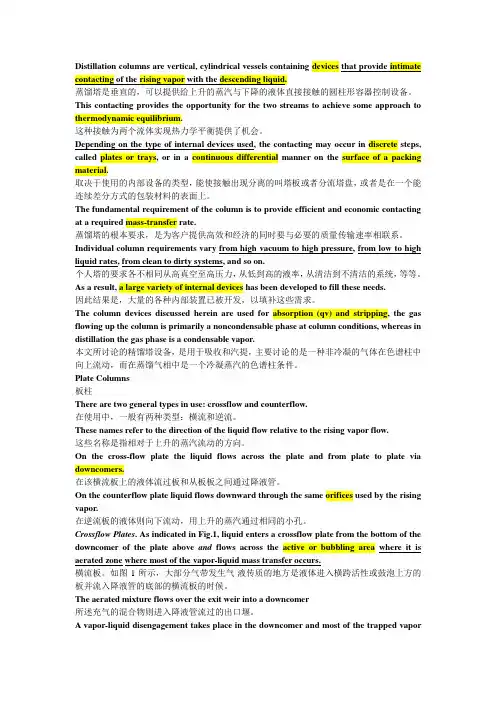
Distillation columns are vertical, cylindrical vessels containing devices that provide intimate contacting of the rising vapor with the descending liquid.蒸馏塔是垂直的,可以提供给上升的蒸汽与下降的液体直接接触的圆柱形容器控制设备。
This contacting provides the opportunity for the two streams to achieve some approach to thermodynamic equilibrium.这种接触为两个流体实现热力学平衡提供了机会。
Depending on the type of internal devices used, the contacting may occur in discrete steps, called plates or trays, or in a continuous differential manner on the surface of a packing material.取决于使用的内部设备的类型,能使接触出现分离的叫塔板或者分流塔盘,或者是在一个能连续差分方式的包装材料的表面上。
The fundamental requirement of the column is to provide efficient and economic contacting at a required mass-transfer rate.蒸馏塔的根本要求,是为客户提供高效和经济的同时要与必要的质量传输速率相联系。
Individual column requirements vary from high vacuum to high pressure, from low to high liquid rates, from clean to dirty systems, and so on.个人塔的要求各不相同从高真空至高压力,从低到高的液率,从清洁到不清洁的系统,等等。
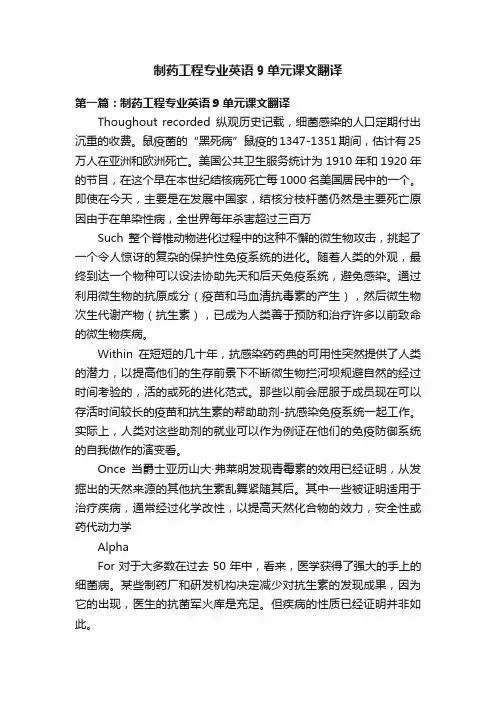
制药工程专业英语9单元课文翻译第一篇:制药工程专业英语9单元课文翻译Thoughout recorded纵观历史记载,细菌感染的人口定期付出沉重的收费。
鼠疫菌的“黑死病”鼠疫的1347-1351期间,估计有25万人在亚洲和欧洲死亡。
美国公共卫生服务统计为1910年和1920年的节目,在这个早在本世纪结核病死亡每1000名美国居民中的一个。
即使在今天,主要是在发展中国家,结核分枝杆菌仍然是主要死亡原因由于在单染性病,全世界每年杀害超过三百万Such 整个脊椎动物进化过程中的这种不懈的微生物攻击,挑起了一个令人惊讶的复杂的保护性免疫系统的进化。
随着人类的外观,最终到达一个物种可以设法协助先天和后天免疫系统,避免感染。
通过利用微生物的抗原成分(疫苗和马血清抗毒素的产生),然后微生物次生代谢产物(抗生素),已成为人类善于预防和治疗许多以前致命的微生物疾病。
Within在短短的几十年,抗感染药药典的可用性突然提供了人类的潜力,以提高他们的生存前景下不断微生物拦河坝规避自然的经过时间考验的,活的或死的进化范式。
那些以前会屈服于成员现在可以存活时间较长的疫苗和抗生素的帮助助剂-抗感染免疫系统一起工作。
实际上,人类对这些助剂的就业可以作为例证在他们的免疫防御系统的自我做作的演变看。
Once当爵士亚历山大·弗莱明发现青霉素的效用已经证明,从发掘出的天然来源的其他抗生素乱舞紧随其后。
其中一些被证明适用于治疗疾病,通常经过化学改性,以提高天然化合物的效力,安全性或药代动力学AlphaFor对于大多数在过去50年中,看来,医学获得了强大的手上的细菌病。
某些制药厂和研发机构决定减少对抗生素的发现成果,因为它的出现,医生的抗菌军火库是充足。
但疾病的性质已经证明并非如此。
The在多种抗生素耐药病原体的发病率迅速升级现在提高全球非常严重的问题。
这种发展突出了强大的进化能力的细菌种群的选择压力下的抗生素治疗。
Resistance抗药性问题被视为与革兰氏阴性(例如大肠杆菌)和革兰氏阳性菌(如金黄色葡萄球菌),但目前关注的最后一组的病原体。
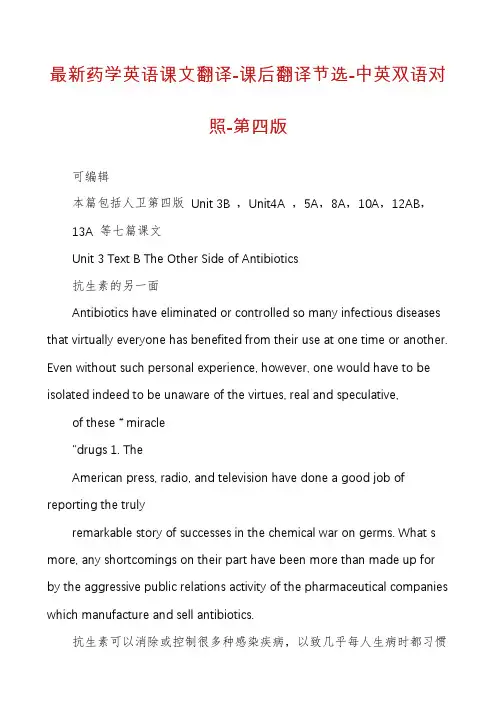
最新药学英语课文翻译-课后翻译节选-中英双语对照-第四版可编辑本篇包括人卫第四版Unit 3B ,Unit4A ,5A,8A,10A,12AB,13A 等七篇课文Unit 3 Text B The Other Side of Antibiotics抗生素的另一面Antibiotics have eliminated or controlled so many infectious diseases that virtually everyone has benefited from their use at one time or another. Even without such personal experience, however, one would have to be isolated indeed to be unaware of the virtues, real and speculative, of these “ miracle”drugs 1. TheAmerican press, radio, and television have done a good job of reporting the trulyremarkable story of successes in the chemical war on germs. What s more, any shortcomings on their part have been more than made up for by the aggressive public relations activity of the pharmaceutical companies which manufacture and sell antibiotics.抗生素可以消除或控制很多种感染疾病,以致几乎每人生病时都习惯于使用它而受益,但是如果一个人没有这样的亲身经历,他必定是离群索居才会不知道这些“特效药物”或真实或推测的优点。
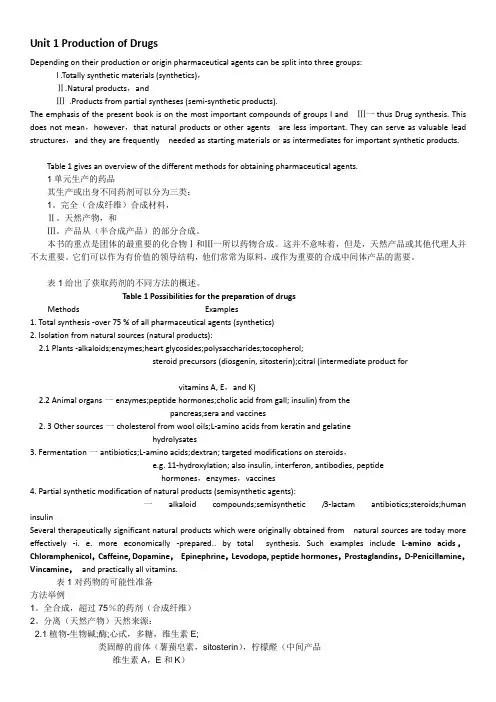
Unit 1 Production of DrugsDepending on their production or origin pharmaceutical agents can be split into three groups:I .Totally synthetic materials (synthetics),Ⅱ.Natural products,andⅢ.Products from partial syntheses (semi-synthetic products).The emphasis of the present book is on the most important compounds of groups I and Ⅲ一thus Drug synthesis. This does not mean,however,that natural products or other agents are less important. They can serve as valuable lead structures,and they are frequently needed as starting materials or as intermediates for important synthetic products.Table 1 gives an overview of the different methods for obtaining pharmaceutical agents.1单元生产的药品其生产或出身不同药剂可以分为三类:1。
完全(合成纤维)合成材料,Ⅱ。
天然产物,和Ⅲ。
产品从(半合成产品)的部分合成。
本书的重点是团体的最重要的化合物Ⅰ和Ⅲ一所以药物合成。
这并不意味着,但是,天然产品或其他代理人并不太重要。
它们可以作为有价值的领导结构,他们常常为原料,或作为重要的合成中间体产品的需要。
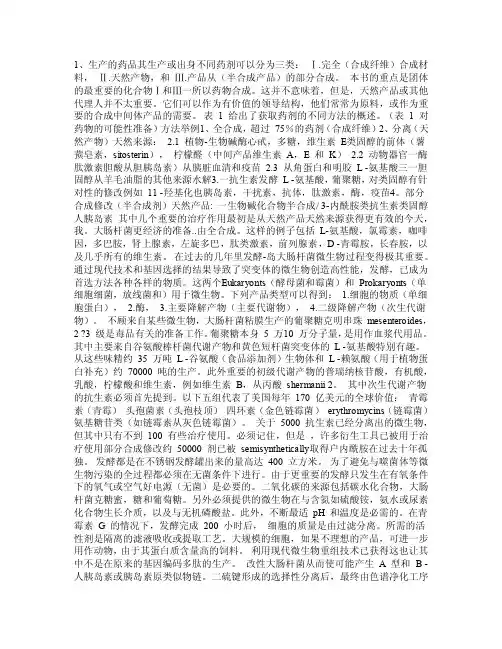
1、生产的药品其生产或出身不同药剂可以分为三类:Ⅰ.完全(合成纤维)合成材料,Ⅱ.天然产物,和Ⅲ.产品从(半合成产品)的部分合成。
本书的重点是团体的最重要的化合物Ⅰ和Ⅲ一所以药物合成。
这并不意味着,但是,天然产品或其他代理人并不太重要。
它们可以作为有价值的领导结构,他们常常为原料,或作为重要的合成中间体产品的需要。
表 1 给出了获取药剂的不同方法的概述。
(表1 对药物的可能性准备)方法举例1、全合成,超过75%的药剂(合成纤维)2、分离(天然产物)天然来源:2.1 植物-生物碱酶心甙,多糖,维生素E类固醇的前体(薯蓣皂素,sitosterin),柠檬醛(中间产品维生素A,E 和K) 2.2 动物器官一酶肽激素胆酸从胆胰岛素)从胰脏血清和疫苗2.3 从角蛋白和明胶L -氨基酸三一胆固醇从羊毛油脂的其他来源水解3.一抗生素发酵L -氨基酸,葡聚糖,对类固醇有针对性的修改例如11 -羟基化也胰岛素,干扰素,抗体,肽激素,酶,疫苗4。
部分合成修改(半合成剂)天然产品: 一生物碱化合物半合成/ 3-内酰胺类抗生素类固醇人胰岛素其中几个重要的治疗作用最初是从天然产品天然来源获得更有效的今天,我。
大肠杆菌更经济的准备..由全合成。
这样的例子包括L-氨基酸,氯霉素,咖啡因,多巴胺,肾上腺素,左旋多巴,肽类激素,前列腺素,D -青霉胺,长春胺,以及几乎所有的维生素。
在过去的几年里发酵-岛大肠杆菌微生物过程变得极其重要。
通过现代技术和基因选择的结果导致了突变体的微生物创造高性能,发酵,已成为首选方法各种各样的物质。
这两个Eukaryonts(酵母菌和霉菌)和Prokaryonts(单细胞细菌,放线菌和)用于微生物。
下列产品类型可以得到:1.细胞的物质(单细胞蛋白), 2.酶, 3.主要降解产物(主要代谢物),4.二级降解产物(次生代谢物)。
不顾来自某些微生物,大肠杆菌粘膜生产的葡聚糖克明串珠mesenteroides,2 ?3 级是毒品有关的准备工作。
专外翻译0901P1 1 The great advantage......to the drug合成和半合成药物的最大优点,是在合成过程中,药物结构的很小变化可能会加强或改善该药物的疗效2 the use of...agent二战期间,使用奎纳克林抑制大面积疟疾的爆发就是化疗药物预防作用的最好例子3 astropine, for example例如,阿托品,阻断神经冲动传递到肌肉和胃肠道腺体,从而大大降低胃肠道系统的蠕动和伟业的分泌,并有利于防止胃溃疡的发生P24 the means ......the second antibictic这意味着大量的微生物通过反复暴露于青霉素而又抗药性,而不变成其他完全不同类别的抗生素。
例如,链霉素,能够成功治疗感染的第二代抗生素5 the considerable medicial.....in modern mediciane可观的医疗和公众的发现和随后的磺胺类药物的广泛使用对健康的重要性,很快的体现在感染引起的发病率和死亡率下降上,在青霉素使用之前,磺胺类药物是主要的抗菌化学药物。
尽管,他们已经代替很大范围的抗生素,他们依然在医学上占据一个尽管很小但很重要的地位P36 in constrast to ....of the body与之进攻微生物而不影响受感染人体的化疗药物相比,药效学药物构成了第二类药物,是通过改变全身系统的生理和生化反应而起作用的7 other drugs may .....or norepinephrine可能通过阻断传递或者作为人工递质作用在被神经释放的正常的递质的接头处的药物不是乙酰胆碱,而是肾上腺素或去甲肾上腺素8 cathartics, drug that ....to prescribe them泻药,促进排泄的药物,对胃肠道其重要作用,泻药被大部分人广泛的滥用,医生们面临着一个泻药的滥用比它被要求开的处方的次数还有多的问题P59 drugs may accumulate.......theraputic responese通过药物结合,消融脂肪或主动运送到细胞而积累到机体的各个部分,这些别储存的药物的有益作用不会丢失,然而积累的地方作为一个储藏库,药物从这里逐渐的释放一段时间来保持较长的治疗作用P610 unfortunately ,.......tolerance disappears不幸的是,对巴比妥盐的镇静催眠的耐药性似乎并不增加致死量,另一方面服用其他的药物的致死量可能增加。
Unit 11 Tablets (The PharmaceuticalTablets Dosage Form)Role in TherapyThe oral route of drug administration is the most important method of administering drugs for systemic effects. Except in cases of Insulin therapy,the parenteral route is not routinely used for self-administration of medications. The topical route of administration has only recently been employed to deliver drugs to the body for systemic effects,with two classes of marketed products: Nitroglycerin for the treatment of angina and scopolamine for the treatment of motion sickness'. Other drugs are certain to follow,but the topical route of administration is limited in its ability to allow effective drug absorption for systemic drug action. The parenteral roue of administration is important in treating medical emergencies in which a subject is comatose or cannot swallow,and in providing various types of maintenance therapy for hospitalized patients. Nevertheless,it is probable that at least 90 0 o of all drugs used to produce systemic effects are administered by the oral rote. When a new drug is discovered,one of the first questions a pharmaceutical company asks is whether or not drug can be effectively administered for its intended effect by the oral route. If it cannot,the drug is primarily relegated to administration in a hospital setting or physician's office. If patient self- administration cannot be achieved,the sales of the drug constitute only a small fraction of what the market would be otherwise. Of drugs that are administered orally,solid oral dosage forms represent the preferred class of product. The reasons for this preference are as follows. Tablets and capsules represent unit dosage forms in which one usual dose of the drug has been accurately placed. By comparison,liquid oral dosage forms,such as syrups,suspensions,emulsions,solutions,and elixirs,are usually designed to contain one dose of medication in 5 to 30 ml. The patient is then asked to measure his or her own medication using a teaspoon,tablespoon,or other measuring device. Such dosage measurements are typically in error by a factor ranging from 20 0 o to 50% o when the drug is self-administered by the patient.Liquid oral dosage forms have other disadvantages and limitations when compared with tablets. They are much more expensive to ship (one liquid dosage weighs 5 g or more versus 0. 25 to 0. 4 g for the average tablet),and breakage or leakage during shipment is a more serious problem with liquids than with tablets. Taste masking of the drug is often a problem (if the drug is in solution even partially). In addition,liquids are less portable and require much more space per number of doses on the pharmacist's shelf. Drugs are in general less 118 stable (both chemically and physically) in liquid form than in a dry state and expiration dates tend to be shorter. Careful attention is required to assure that the product will not allow a heavy microbiologic burden to develop on standing or under normal conditions of use once opened(preservation requirements).There are basically three reasons for having liquid dosage forms of a drug:(1)The liquid form is what the public has come to expect fox certain types of products (e. g. cough medicines).(2) The product is more effective in a liquid form (e. g.,many adsorbents and antacids). (3) The drug(s) are used fairly commonly by young children or the elderly,who have trouble swallowing the solid oral dosage forms.PropertiesThe objective of the design and manufacture of the compressed tablet is to de liver orally the correct amount of drug in the proper form at or over the proper time and in the desired location,and to have its chemical integrity protected to that point. Aside from the physical and chemical properties of the medicinal agent (s)to be formulated into a tablet,the actual physical design,manufacturing process,and complete chemical makeup of the tablet can have a profound effect on the efficacy of the drug(s)being administered.A tablet(1)should be an elegant product having its own identity while being free of defects such as chips,cracks,discoloration,contamination,and the like;(2) should have the strength to withstand the rigors of mechanical shocks(5) encountered in its production,packaging,shipping,and dispensing; and (3) should have the chemical and physical stability to maintain its physical attribute over time. Pharmaceutical scientists now understand that various physical properties of tablets can undergo change under environmental or stress conditions,and that physical stability,through its effect on bioavailability in particular,can be of more significance and concern in some tablet systems than chemical stability.On the other hand,the tablet(1)must be able to release the medicinal agent(s) in the body in a predictable and reproducible manner and (2) must have a suitable chemical stability over time so as not to allow alteration of the medicinal agent(s). In many instances,these sets of objectives are competing. The design a of tablet that emphasizes only the desiredmedicine effects may produce a physically inadequate product. The design of a tablet emphasizing only the physical aspects may produce tablets of limited and varying therapeutic effects. As one example of this point,Meyer and associates present information on 14 Nitrofurantoin products,all of which passed the compendia physical requirements,but showed statistically,significant bioavailability differences.Selected from Lachman Leon et al. The Theory and Practice可Industrial Pharmacy,3 rd ed., Lea and Febiger, Philadelphia, 1986.第3部分工业药物11单元片(该药片剂型)的治疗作用在口服给药途径是全身作用的药物管理最重要的方法。
Unit 1 Production of DrugsDepending on their production or origin pharmaceutical agents can be split into three groups:I .Totally synthetic materials (synthetics),Ⅱ.Natural products,andⅢ.Products from partial syntheses (semi-synthetic products).The emphasis of the present book is on the most important compounds of groups I and Ⅲ一thus Drug synthesis. This does not mean,however,that natural products or other agents are less important. They can serve as valuable lead structures,and they are frequently needed as starting materials or as intermediates for important synthetic products.Table 1 gives an overview of the different methods for obtaining pharmaceutical agents.1单元生产的药品其生产或出身不同药剂可以分为三类:1。
完全(合成纤维)合成材料,Ⅱ。
天然产物,和Ⅲ。
产品从(半合成产品)的部分合成。
本书的重点是团体的最重要的化合物Ⅰ和Ⅲ一所以药物合成。
这并不意味着,但是,天然产品或其他代理人并不太重要。
它们可以作为有价值的领导结构,他们常常为原料,或作为重要的合成中间体产品的需要。
制药工程专业英语翻译一药物生产根据其生产和来源,药物制剂可以分为三类:全合成原料(合成)天然产物3.部分合成产品(半合成)此书的重点在于1和3中最重要的化合物,即药物合成。
然而,这并不是意味着天然产物或其它制剂就不重要。
它们可以作为非常有价值的先导化合物,并且它们经常需要作为重要合成药物的起始原料或者中间体。
表1给出了获得药物制剂的不同方法的概述。
表一制备药物的可能途径2.1植物-生物碱;酶;强心苷;多聚糖;生育酚;类固醇前体(薯芋皂素,谷甾醇);柠檬醛(维生素A、E和K的中间产物)2.2动物组织-酶;肽激素;胆中的胆汁酸;胰腺中的胰岛素;血清和疫苗2.3其它原料-羊毛脂中的胆固醇;来自角蛋白和明胶水解的L-氨基酸3.发酵-抗生素,L-氨基酸;右旋糖苷;目的修饰的类固醇 e.g.11-羟基化作用; 还有胰岛素,干扰素,抗体,肽,酶,维生素4.天然产物部分合成修饰(半合成制剂) -生物碱;半合成-β-内酰胺抗体;甾类;人类胰岛素几种最初来源与天然原料的在治疗学上有重大意义的天然产物今天更加有影响力,即,通过全合成制备更加经济。
这样的例子包括L-氨基酸,氯霉素,咖啡因,多巴胺,肾上腺素,左旋多巴,肽类荷尔蒙,前列腺素,D-青霉胺,长春胺和几乎所有的维生素。
最近几年,发酵,即微生物过程,已经变得非常重要。
利用现代技术和遗传选择的结果产生了高生产性能的微生物突变株,发酵已经成为对于广泛底物都选择的一种方法。
真核微生物(酵母和霉菌)和原核微生物(单细胞细菌和放线菌)都可以作为生产菌株。
可以获得下面的典型产物:1、细胞原料(单细胞蛋白)2、酶3、初级降解产物(初级代谢产物)4、次级降解产物(次级代谢产物)不考虑从特种微生物的粘液膜组织生产右旋糖苷,例如,肠膜明串珠菌,第2类和第3类对于药物的生产是一致的。
右旋糖苷分子量为50,000-100,000,其本身可作为血浆的替代品。
在初级代谢产物中,利用谷氨酸棒杆菌和黄色短杆菌的突变株生产L-氨基酸特别具有意义。
Unit 13 Sterile ProductsSterile ProductsSterile products are dosage forms of therapeutic agents that are free of viable microorganisms. Principally,these include parenteral,ophthalmic,irrigating preparations. Of these, and parenteral products are unique among dosage forms of drugs because they are injected through the skin or mucous membranes into internal body compartment. Thus,because they have circumvented the highly efficient first line of body defense,the skin and mucous membranes,they must be free from microbial contamination and from toxic components as well as possess an exceptionally high level of purity. All components and processes involved in the preparation of these products must be selected and designed to eliminate,as much as possible,contamination of all types,whether of physical,chemical,or microbiologic origin.Preparations for the eye, though not introduced into internal body cavities,are placed in contact with tissues that are very sensitive to contamination. Therefore,similar standards are required for ophthalmic preparations).Irrigating solutions are now also required to meet the same standards as parenteral solutions because during an irrigation procedure,substantial amounts of these solutions can enter the bloodstream directly through open blood vessels of wounds or abraded mucous membranes. Therefore,the characteristics and standards presented in this chapter for the production of large-volume parenteral solutions apply equally to irrigating solutions. Sterile products are most frequently solutions or suspensions,but may even be solid pellets for tissue implantation. The control of a process to minimize contamination for a small quantity of such a product can be achieved with relative ease. As the quantity of product increases,the problems of controlling the process to prevent contamination multiply. Therefore,the preparation of sterile products has become a highly specialized area in pharmaceutical processing. The standards established,the attitude of personnel,and the process control must be of a第13 单元无菌产品无菌产品无菌产品是不含微生物活体的治疗剂剂型,其主要包括非肠道用的、眼用的和冲洗用的制剂。
这之中,非肠道用产品在药物剂型当中是(较为)特别的因为它们是通过皮肤和黏膜被注射到人体内部的。
这样,由于它们进入了高效率的人体第一道免疫防线——皮肤和黏膜,(所以)它们必须没有微生物感染和有毒成分,同时又(必须)具有特别高的纯度。
这些产品的制备过程中涉及到的所有组分和(工艺)流程都必须经过选择和设计以尽可能地消除各种类型的污染,无论是来自物理的、化学的,还是微生物的。
眼用制剂尽管没有被引入到内部体腔,但它仍与对污染(物)敏感的组织有接触,因此,对眼用制剂也要求(与非肠道用制剂)类似的标准。
冲洗液现在也要求满足和非肠道用溶液一样的标准,因为在冲洗过程中,大量的冲洗液都可以通过敞开的血管伤口或者擦伤的黏膜组织直接进入到血液。
因此,本章中描述的有关非肠道用溶液大批量生产的特点和标准,对于冲洗液同样适用。
无菌产品通常是溶液或者悬浮液,但甚至也可以是用于组织对端植入的固体药丸。
对于少量的这种产品,使其污染降到最低的工艺控制可以相对容易地实现。
(但)随着产品量的增加,控制工艺流程从而防止污染的困难也会增加。
因而,无菌产品的制备已经成为药品加工里一个高度专业化的领域。
制定的标准、人员的态度和工艺流程的控制都必须有着优秀的水平。
superior level.VehiclesBy far the most frequently employed vehicle for sterile products is water,since it is the vehicle for all natural body fluids. The superior quality required for such use is described in the monograph on Water for Injection in the USP. Requirements may be even more stringent for some products,however.One of the most inclusive tests for the quality of water is the total solids content,a gravimetric evaluation of the dissociated and undissociated organic and inorganic substances present in the water. However,a less time-consuming test,the electrolytic measurement of conductivity of the water,is the one most frequently used. Instantaneous measurements can be obtained by immersing electrodes in the water and measuring the specific conductance, a measurement that depends on the ionic content of the water. The conductance may be expressed by the meter scale as conductivity in micromhos ,resistance in megohms , or ionic content as parts per million (ppm) of sodium chloride. The validity of this measurement as an indication of the purity of the water is inferential in that methods of producing high-purity water,such as distillation and reverse osmosis,can be expected to remove undissociated substances along with those that are dissociated. Undissociated substances such as pyrogens,however,could be present in the absence of ions and not be disclosed by the test. Therefore,for contaminants other than ions,additional tests should be performed.Additional tests for quality of Water for Injection with permitted limits are described in the USP monographs. When comparing the total solids permitted for Water for Injection with that for Sterile Water for Injection,one will note that considerably higher values are permitted for Sterile Water for Injection. This is necessary because the latter product has been sterilized,usually by a thermal method,in a container that has dissolved to some extent in the water. Therefore,the solids content will be greater than for the nonsterilized product. On the other hand,the 10 ppm total solids officially permitted for Water for Injection may be much too high when used as the vehicle for many products. In practice, Water for Injection normally should not have a conductivity of more than 1micromho (1 megohm,approximately 0. 1 ppm NaCl).溶媒到目前为止,最常被用于无菌产品的溶媒就是水,因为水(也)是所有自然体液的溶媒。